Alienware Aurora R15 review: Cool under pressure
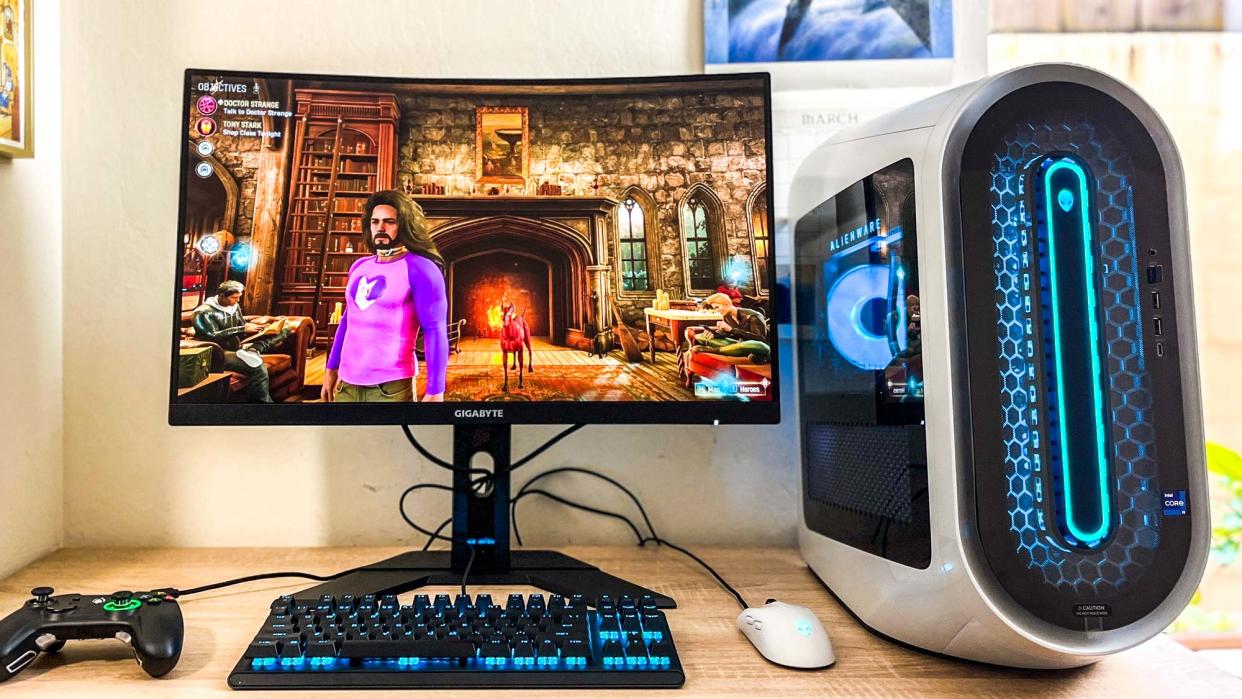
Alienware Aurora R15 specs (as reviewed)
Price: $4,588 as reviewed
Processor: Intel Core i9-13900KF
RAM: 32 GB
Graphics Card: Nvidia GeForce RTX 4090
Storage: 1 TB SSD, 1 TB HDD
Ports: USB-A, USB-C, 3.5 mm audio, Ethernet, DisplayPort, HDMI, SPDIF, surround sound
Size: 23.2 x 20.1 x 8.86 inches
Weight: Up to 36.4 pounds (depending on config)
The Alienware Aurora R15 ($1,199 to start) is an excellent gaming PC that improves upon its predecessors in a few key ways, packing the most powerful components you can afford in an attractive, easy-to-open chassis.
Though that chassis looks awfully similar to the Legend 2.0 case which debuted last year with the Aurora R13, Alienware claims to have redesigned it to run cooler and quieter, and my experience putting our review unit through its paces bears that out.
But while case design is a surprisingly important part of choosing the best gaming PC for you given that their internals are typically highly customizable (and thus not a meaningful differentiator between PCs), it's far from the most exciting aspect of these machines. No, what we get most hyped about is how well a gaming PC plays the latest and greatest games with all the settings cranked to max.
When Alienware sent us a tricked-out Aurora R15 review unit with an RTX 4090 and a high-end 13th Gen Intel CPU I did everything I could to bring it to its knees, but even when gaming at 4K with every bell and whistle firing it ran whisper-quiet and delivered great framerates. That level of performance is far from cheap, but if you can afford it this is a gaming PC that will last you for years to come.
Alienware Aurora R15 review: Price and availability
Starts at $1,399, but you can easily pay over $5k if you want the best
Highly customizable with the latest from AMD, Intel and Nvidia
The Alienware Aurora R15 is available for purchase right now via Dell's website in either white or black (Lunar Light and Dark Side of the Moon, technically), and you can order a stock config or customize your own. The price tag on this Windows 11 gaming PC starts as low as $1,199 (at time of review), and for that, you get a 13th Gen Intel Core i5 CPU, an Nvidia GeForce RTX 3050 GPU, 8GB of DDR5 RAM and a 256GB SSD for storage.
That's a decent machine for the price and it should be able to run many games well enough (though 8GB of RAM really isn't much, so you should probably add more), but it won't play the latest and greatest PC games at high resolution with great framerates.
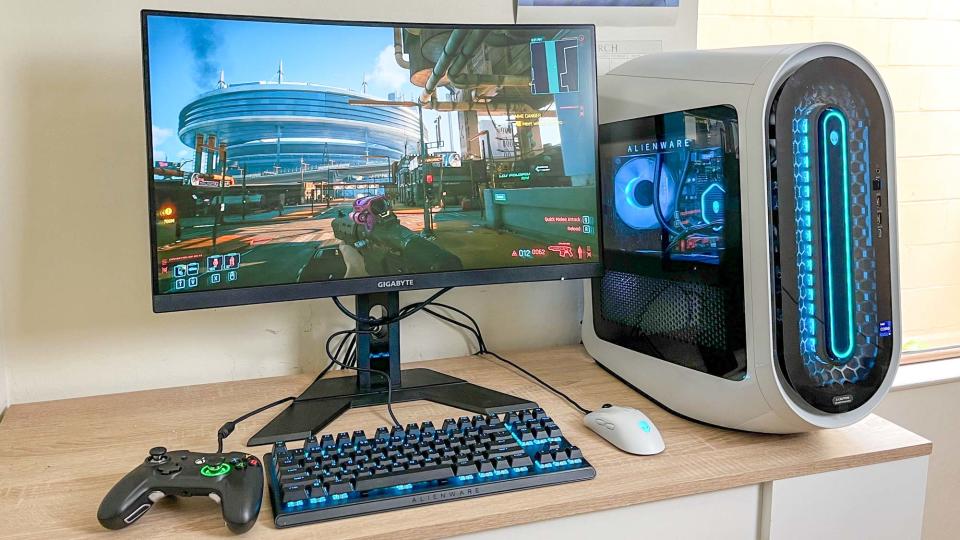
Of course, Alienware is happy to sell you more power if you can afford it. The company offers at least 7 pre-configured builds of the Aurora R15 on its website, some with Intel CPUs and others with AMD chips.
The price tag for these builds ranges as high as $4,499, and for that you get a top-of-the-line liquid-cooled R15 with a 13th Gen Intel Core i9-13900KF CPU, an Nvidia Geforce RTX 4090 GPU, 32GB of DDR5 RAM and a 1TB SSD for booting plus another 1TB hard disk drive (HDD) spinning at 7,200 RPM for added storage. It's a beefy rig, as befits a nearly $5k price tag, and it's what Alienware sent us to review.
But for true enthusiasts, Alienware offers the option of configuring your own build. In addition to the remarkably powerful Intel Core i9-13900KF CPU and GeForce RTX 4090 GPU, you can configure an Aurora R15 with up to 64GB of DDR5 RAM (at either 4800MHz or the faster, more expensive 5200MHz) and up to a 4TB SSD + a 2TB hard drive. Such a rig would cost you roughly $5,500, though it could climb even higher if you splurged for a Pro copy of Windows 11 and some of Alienware's gaming accessories.
Alienware Aurora R15 review: Design
Redesigned Legend chassis runs cool and quiet, still looks great
Those fins on the back can leave wicked scratches on your wall
The Aurora R15 looks very similar to its predecessor the Alienware Aurora R13 at a glance, from the reclining oval face to the stubby fins on the back that left a few scratches on the wall behind my desk.
Dig deeper and you'll see how Alienware has redesigned the case to improve airflow by, among other things, punching some hexagonal holes in the side and expanding the cooling complement for high-end models (those with an Intel CPU ending in "K", denoting overclock capabilities) to a set of five 120mm case fans. The company also changed up the motherboard's design and relocated some things within the case to try and make room for today's beefy GPUs while ensuring the R15 runs quieter and cooler.
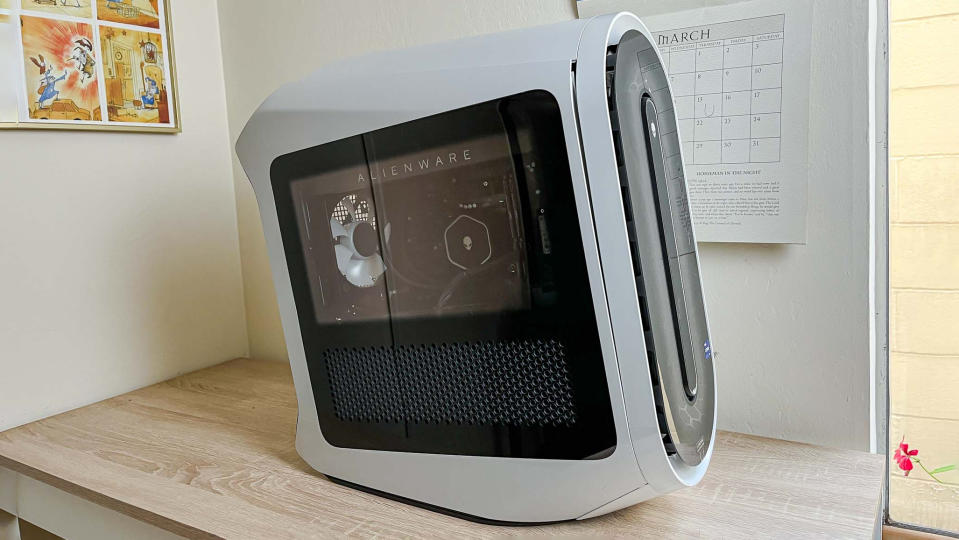
After spending some time with our review unit I can't say for sure how much quieter it is than the R13 I reviewed last year, but I can say I barely noticed any fan noise or heat from the R15, even after spending hours playing a game like Cyberpunk 2077 at 4K resolution with all setting maxed. This is a nice change from when I was playing the same game on the older R13, since I can remember that machine getting a bit louder and putting out a noticeable amount of hot air after I'd been playing for an hour or two.
I barely noticed any fan noise or heat from the R15, even after spending hours playing a game like Cyberpunk 2077 at 4K with all setting maxed."
Like the R13, the new Alienware Aurora R15 has an optional clear glass side panel (not available on all models) which lets you peer inside your PC to watch the components at work. New to the R15 is the aforementioned grille of hexagonal cutouts along the bottom half of the panel for improved airflow. If you want to get inside the PC this is the panel you want to remove, and it's easy to do: simply unscrew one screw on the back of the PC and then (gently) pry it off. You can pull the other side off as well, and even the top of the case if you want to break out a screwdriver, but you can get to most of the PC's innards just from the left side panel.
You can get around inside to just about anything you need to, but expect it to take a while—the case is tightly organized, and there are more than one or two brackets that stay between you and some areas of the case. This is the trade-off you make for the Aurora R15's attractive case design and relatively compact size: Limited upgradability.
Still, it's not hard to see the appeal of the Aurora R15 at a glance. The oblong case is easy on the eyes and, if not exactly light, at least more convenient to lug around than many full-sized gaming PCs. Not long ago I reviewed the Acer Predator Orion 7000, another great gaming PC that comes in a full tower case, and if I had to pick one to carry up a flight of stairs, I'd go Aurora every time.
Alienware Aurora R15 review: Ports and upgradability
Plenty of ports on front and back, though none up top
Case is easy to open, but difficult to work in
That removable side panel is one of the nicer aspects of the Aurora R15's design because it makes it awfully easy to get into the PC and start mucking around. I really like this ease of access to the case, even if I'm less fond of the way Alienware routes as many cables as possible behind the motherboard and up the right side. This keeps cable clutter minimal in the case (which looks great) but can make it tricky to modify or add your own touches since you'll need to work within the limits of the case.
This is true for working within the case in general: It's easy enough to get in there and start fiddling with things, but you'll be hampered by Alienware's design work. While swapping in new RAM is easy enough, expect to have to remove brackets and move components around to do more complicated things like swapping out a GPU in the case. Since Alienware uses a proprietary motherboard, your options for upgrading it (and by extension the CPU) down the road are limited at best.
Alienware's Aurora R15 sports all the ports a PC gaming enthusiast could want, with some on the front and the rest on the rear. However, you won't find any top-mounted ports on this PC, which might be a bummer for those who like to keep their gaming rig on the floor.
While plugging things into the front of the case does mar the clean lines of the R15 somewhat, you can't beat the convenience. Up front you get a headphone jack and a vertical lineup of USB-C ports: 2x USB-A 3.2 Gen 1, another USB-A 3.2 Gen 1 with PowerShare (which just means the port delivers power to connected devices even when the PC is switched off) and a USB-C Gen 2 port with PowerShare.
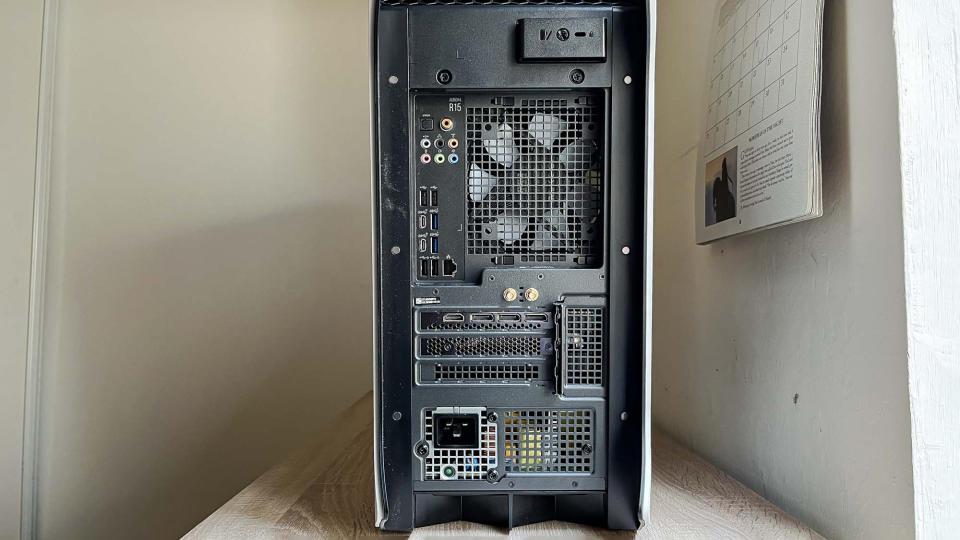
But that's just a teaser. The real port smorgasbord is on the back of the PC, where you get a quartet of classic USB-A 2.0 ports as well as a newer USB-A 3.2 Gen 1 port, a USB-C 3.2 Gen 2 port and a USB-C 3.2 Gen 2x2 port. As far as graphics go, your GPU choice will dictate what sorts of port options you have for outputting to monitors, and the 4090 in our review unit offers 3 DisplayPort jacks and one HDMI out.
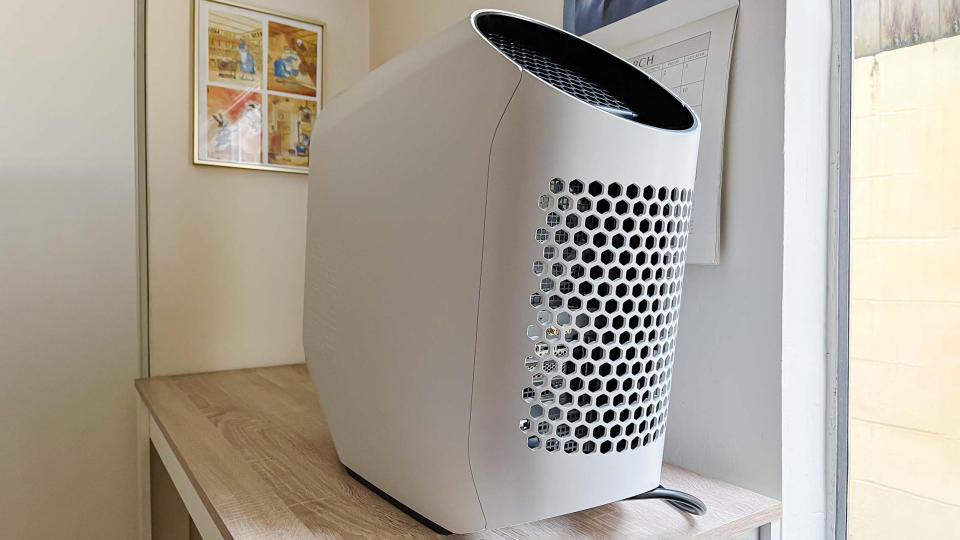
If you want to invest in a serious speaker setup to go with your new gaming PC, the Aurora R15 sports the ports you want. In addition to side, rear and center/subwoofer output ports you get line in and line out, a microphone in, and two SPDIF digital outputs: one for Toslink cables and the other for coax.
You'll want to plug into a high-speed wired Internet connection for online gaming, of course, so it's nice to see the Aurora R15 also includes an RJ-45 jack with support for Intel's Killer E3100G Gigabit Ethernet.
The Aurora R15 also comes with a detachable rear cover you can slide over the back of the PC to help route cables and hide them from view.
Alienware Aurora R15 review: Gaming performance
Our ~$5K review unit excels at 4K gaming thanks to Nvidia's RTX 4090
...but you can get nearly as good gaming performance from a PC over $1k less
The Alienware Aurora R15 unit we received for review is an excellent gaming machine thanks to its GeForce RTX 4090 GPU, Core i9 CPU and 32GB of DDR5 RAM. I enjoyed my time reviewing this PC immensely, as it had no trouble running any game I cared to launch.
At home, I have a dual-monitor setup, one 1080p and one 1440p, and our Aurora R15 was able to run everything from Cyberpunk 2077 to Death Stranding to Marvel's Midnight Suns at 1440p with all the settings maxed out. With most games, it had no trouble delivering 60 frames per second or better, especially when I flipped on Nvidia's DLSS (Deep Learning Super Sampling) in games that support it.
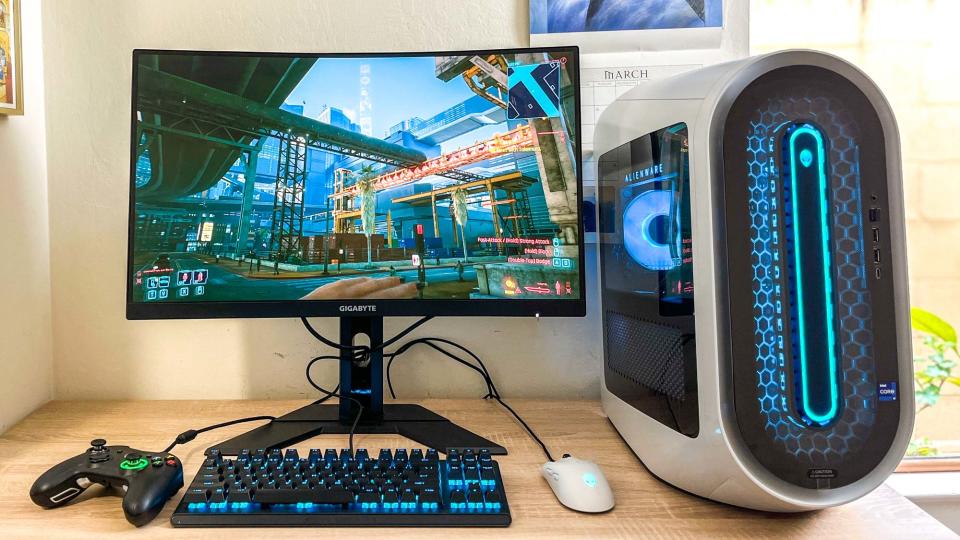
Even when I (carefully) dragged the Aurora R15 over to my LG C2 OLED TV and hooked it up to see how well it could spit game at 4K, I was not disappointed. While our Aurora R15 review unit could only manage between 30-40 fps while running Cyberpunk 2077 at 4K with all settings cranked to max, that was before I flipped on Nvidia's DLSS.
Nvidia rolled out a new version of the tech (DLSS 3) alongside its GeForce RTX 4000 series, and Cyberpunk 2077 was one of the first games to get updated with support for DLSS 3. Not only does DLSS 3 tap the Tensor Cores in Nvidia GPUs to dynamically enhance image quality while you're playing, it actually inserts new frames in between frames of gameplay. It can be confusing to understand when you read about it, but once I saw it in action on our Aurora R15 I was impressed by how much it improved my experience of playing Cyberpunk 2077 without any noticeable graphical issues. When I would use older versions of DLSS in times gone by I would often notice graphical distortions cropping up that made it appear as though the image was being smeared or blurred out slightly, especially during scenes of fast action.
If you want a great PC for gaming at 4K, Alienware delivers with the Aurora R15—assuming you're willing to pay for the privilege."
Not so with DLSS 3 and Cyberpunk 2077. When I flipped on DLSS 3 in the game's settings, that 30-40 fps at 4K shot up to 100-120 fps, with no noticeable degradation in image quality. If DLSS 3 can do for every game what it did for my experience playing Cyberpunk at 4K, call me a believer.
Of course, we don't just rely on our own anecdotal experience when reviewing PCs here at Tom's Guide. We also run every machine through our testing lab (don't miss our guide to how we test products), where we subject it to a battery of performance tests to see how it stacks up against the competition.
As you might expect, our nearly $5K review unit achieved high scores across the board in these tests. In fact, it significantly outperformed some of the most powerful gaming PCs we've tested in the last year, including the Origin PC Millennium (2022) (i9-12900K, GeForce RTX 3080 Ti, 32GB RAM) and the Corsair One i300 (i9-12900K, GeForce RTX 3080 Ti, 64GB RAM).
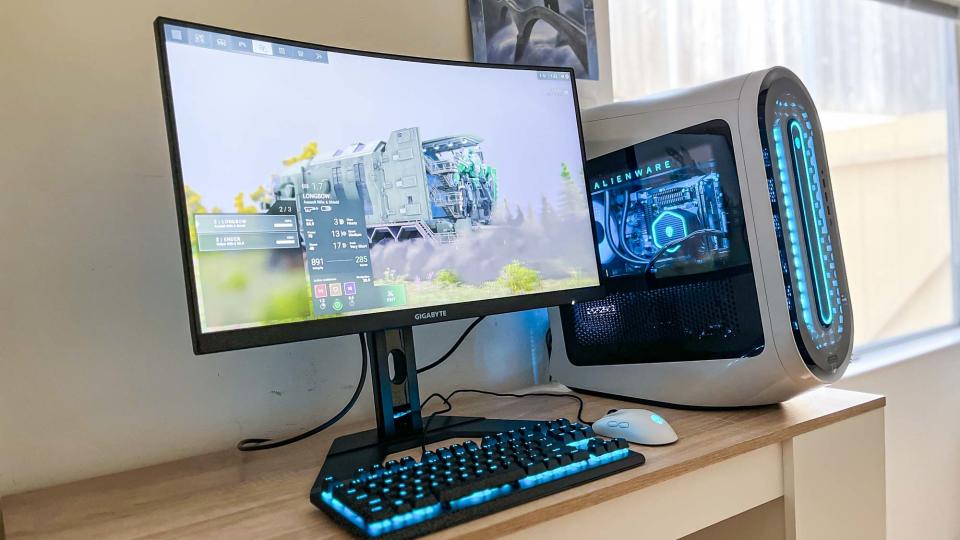
However, keep in mind those are older PCs packing last-gen parts. We haven't tested a ton of 2023 PCs with the latest and greatest components yet, but we did recently test a cheaper Origin Chronos V3 gaming PC (priced upwards of $3.5K) with only slightly less powerful guts—specifically, it arrived with an Intel Core i9-13900K CPU, an Nvidia GeForce RTX 4080 GPU and 32GB of RAM. Our Aurora R15 review unit still managed to outperform this Origin in nearly every gaming benchmark, but as you can see from the chart of results above, the two were neck-and-neck in many of them.
So if you want a great PC for gaming at 4K, Alienware delivers with the Aurora R15—assuming you're willing to pay for the privilege.
Alienware Aurora R15 review: Overall performance
13th Gen Intel Core i9 CPU blazes through performance benchmarks
Excellent ray tracing, but cheaper PCs outperform this monster elsewhere
You shouldn't need to worry about performance when using a gaming PC for day-to-day work tasks, especially when that PC cost you nearly $5K. The Aurora R15 meets that expectation with flying colors, as it ran whisper-quiet and never hitched or froze no matter how many browser tabs, productivity applications and streams of data I opened at once.
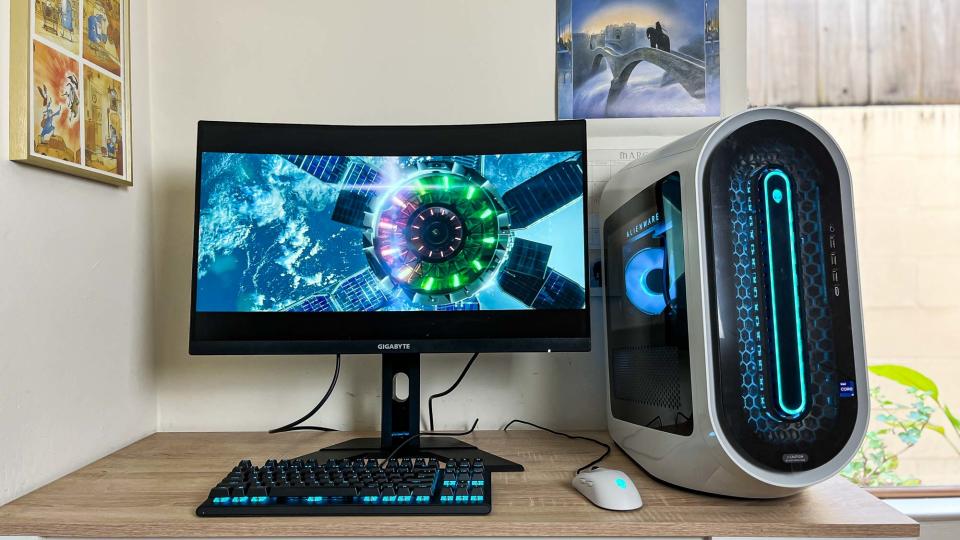
Our performance tests reveal that this is an excellent machine for running demanding applications for work like video editing, game development and the like, but you could have guessed that from the smorgasbord of high-powered parts inside. However, it was again neck-and-neck with the new Origin Chronos V3 we just tested, which managed to outperform the Aurora R15 in a few key areas.
Notably, our Alienware Aurora R15 review unit was less speedy than the Origin Chronos V3 in terms of CPU performance (22,494 vs 24,054), file transfer speeds (1,340 MBps vs 1,809) and video editing performance (3:12 vs 2:48), which we measure by timing how long it takes the PC to transcode a 4K video down to 1080p using Handbrake.
We also run every PC we review through a few benchmarks designed to evaluate how well it performs at tasks like rendering graphics (3DMark), editing media like photos in Adobe Photoshop Elements (HDXPRT 4), or more esoteric computing tasks like facial recognition (CrossMark). As you might expect, our Aurora R15 performed quite well in these tests, putting up high scores across the board.
Here again, the Origin Chronos V3 put up better numbers than our Aurora R15 review unit in CrossMark and HDXPRT 4, though the difference between the two is relatively small. However, the power of the RTX 4090 helped the R15 achieve a far better score than the Chronos in 3DMark's Port Royal test, which evaluates how well a PC handles ray tracing.
Given that this is a machine tuned for gaming it's nice to see that it excels in the ray tracing department, since ray tracing tech is showing up in more and more games every year.
Alienware Aurora R15 review: Software
Minimal bloatware, which is great
Alienware Command Center is the MVP
There wasn't much installed on our Aurora R15 review unit when it arrived save Windows 11 and a few Dell/Alienware applications you'll rarely touch, including My Alienware, Alienware Customer Connect and Alienware Update (which you use to do things like update your BIOS).
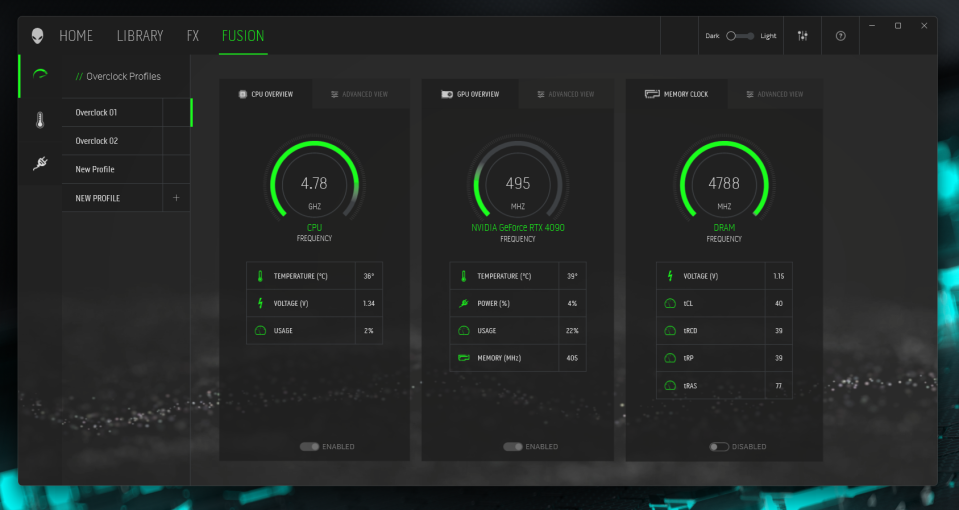
The one piece of pre-installed software you'll likely use a lot is the Alienware Command Center. This is the most feature-rich Alienware app on the system, as it allows you to do things like monitor and manage your system cooling, create and implement system overclock profiles, customize the case's RGB lighting and more.
Alienware Aurora R15 review: Verdict
The Alienware Aurora R15 is a great gaming PC that improves upon its predecessors in small but meaningful ways. While how well it plays games will depend on what you can afford to put in it, getting in there is easy thanks to the accessible design of the case.
The fact that our Aurora R15 review unit never got hot or loud during the review process, even when playing demanding games at 4K for hours with all settings cranked to max, suggests Alienware's efforts to improve the case design paid off. While ours is admittedly liquid-cooled with Alienware's Cryo-Tech cooler, which is only available on the higher-end models (the cheapest Aurora R15 units are simply air-cooled), the cost of adding such cooling to an R15 is a few hundred bucks. Not cheap, but certainly not on the level of upgrading the GPU to the 4090 in our review unit.
And really, that's the main appeal of this PC: You can get one with the latest and greatest components inside, and my experience playing games on one suggests it's worth the high cost of entry. Of course, more and more PCs with 13th Gen Intel chips and 40-series Nvidia GPUs are hitting the market every week, some of which (like the Origin Chronos V3 we're reviewing) might actually outperform the R15 in some areas despite costing less.
But even the truly flush who are out there scouring storefronts for the perfect RTX 4090-powered gaming PC would be well-served by the Aurora R15 thanks to its easy-to-access case and excellent cooling. Plus, it looks really good on a desk.


